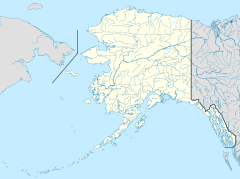Ridgeway, Alaska facts for kids
Quick facts for kids
Ridgeway, Alaska
|
|
|---|---|
| Country | United States |
| State | Alaska |
| Borough | Kenai Peninsula |
| Area | |
| • Total | 17.68 sq mi (45.80 km2) |
| • Land | 16.79 sq mi (43.48 km2) |
| • Water | 0.90 sq mi (2.32 km2) |
| Elevation | 187 ft (57 m) |
| Population
(2020)
|
|
| • Total | 2,136 |
| • Density | 127.23/sq mi (49.13/km2) |
| Time zone | UTC-9 (Alaska (AKST)) |
| • Summer (DST) | UTC-8 (AKDT) |
| Area code(s) | 907 |
| FIPS code | 02-65345 |
| GNIS feature ID | 1866972 |
Ridgeway is a small community located in Alaska, United States. It is known as a census-designated place (CDP). A CDP is an area that the government identifies for counting people, but it is not an officially incorporated city or town. In 2020, the population of Ridgeway was 2,136 people. This was a slight increase from the 2,022 people counted in 2010.
Contents
Where is Ridgeway Located?
Ridgeway is found on the western side of the Kenai Peninsula in Alaska. It is located at 60°31′11″N 151°3′39″W / 60.51972°N 151.06083°W. The community shares its borders with several other places. To the northwest, it is next to the city of Kenai. To the south, it borders the city of Soldotna, which is the main government center for the borough.
To the east, across Soldotna Creek, you'll find the Sterling CDP. To the west, across the Kenai River, is the Kalifornsky CDP.
Land and Water Area
According to the United States Census Bureau, the Ridgeway CDP covers a total area of about 45.8 square kilometers (17.7 square miles). Most of this area is land, measuring about 43.5 square kilometers (16.8 square miles). The rest, about 2.3 square kilometers (0.9 square miles), is water. This means about 5.13% of Ridgeway's total area is water.
Who Lives in Ridgeway?
Ridgeway was first recognized as a census-designated place in the 1990 U.S. Census.
| Historical population | |||
|---|---|---|---|
| Census | Pop. | %± | |
| 1990 | 2,018 | — | |
| 2000 | 1,932 | −4.3% | |
| 2010 | 2,022 | 4.7% | |
| 2020 | 2,136 | 5.6% | |
| source: | |||
Population in 2000
In the year 2000, there were 1,932 people living in Ridgeway. These people lived in 715 households, with 536 of them being families. The population density was about 116 people per square mile (44.8 people per square kilometer). There were also 938 housing units, with an average of 56.3 units per square mile (21.7 units per square kilometer).
Most of the people in Ridgeway in 2000 were White (87.8%). Other groups included Native American (4.3%), Asian (0.8%), and Black or African American (0.4%). About 5.1% of the population identified as being from two or more races. About 2.5% of the population was Hispanic or Latino.
Households and Families
Out of the 715 households in 2000, 39.3% had children under 18 living with them. A large portion, 62.5%, were married couples living together. About 9.5% of households had a female head of household with no husband present. Around 24.9% of households were made up of non-families.
About 18.9% of all households consisted of individuals living alone. Only 4.2% of households had someone living alone who was 65 years old or older. The average household had about 2.70 people, and the average family had about 3.09 people.
Age Distribution
The population in Ridgeway in 2000 was spread across different age groups. About 29.5% of the people were under 18 years old. Those aged 18 to 24 made up 6.7% of the population. People aged 25 to 44 accounted for 26.5%, and those aged 45 to 64 made up 31.0%. About 6.4% of the population was 65 years old or older. The average age in Ridgeway was 38 years.
For every 100 females, there were about 98.6 males. When looking at adults aged 18 and over, there were about 99.3 males for every 100 females.
Income and Economy
In 2000, the median income for a household in Ridgeway was $50,625. For families, the median income was $56,985. Males generally earned more, with a median income of $51,488, compared to $36,786 for females. The per capita income for the CDP was $23,225.
About 7.4% of families and 9.4% of the total population lived below the poverty line. This included 11.6% of those under 18 years old and 15.5% of those aged 65 or older.
See also
 In Spanish: Ridgeway (Alaska) para niños
In Spanish: Ridgeway (Alaska) para niños


